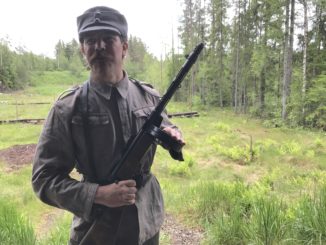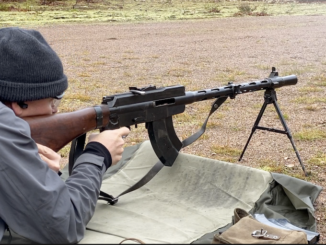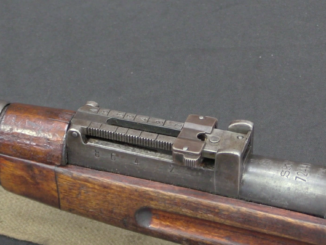For my main run through Desert Brutality this year, I decided to have fun with a full historical load out – or at least a mostly-historical load out. I used a Valmet M62/S (the semiauto version of the Finnish Rk62 military rifle) and a Lahti L-35 (Finland’s domestic military pistol). To go along with this, I had a set of Finnish M91 camouflage generously gifted to me by one of the Finnish Brutality 2022 competitors, and a set of Finnish M62 web gear. I dropped one of the magazine pouches and replaced with with a Swedish M40 Lahti holster, which worked surprisingly well.
The uniform didn’t really fit right and the web gear was pretty heavy and mediocre, so really the only inaccurate element was that I was wearing really nice modern boots instead of ill-fitting Finnish surplus rubber ones.
Despite some difficulty on some of the shooting challenges (mores on the rifle than the pistol), I was able to complete the entire match without penalties – the first time I have managed to do that in a Brutality match! I placed 3rd of the 16 people in Iron Sights division and 23rd of 174 competitors total.




Stupid question: which brand of ammunition did the pistol prefer? I know that not all 9x19mm cartridges are loaded with the same kind of powder or projectiles.
Lahti L-35 was designed for 9×19 Luger/Parabellum cartridge with 8 gram / 123 gr FMJ with 290 m/s bullet velocity. Heavier loads damage pistols slides. Many were broken by using ammo made for Suomi-smg.
I just love how Ian uses “antiquated” guns and still places well. So tell me again how great and necessary progress is.
The problem is how we define “progress.”
It’s a spectrum. Randomly put two kids from your neighborhood on bikes; one of them on whatever Big Box Store Chinesium chunker you can find easily, and the other on top of a high-end Trek. Odds are, up to a point, the bikes won’t make a difference. After those kids get past that point, then the kid on the high-end Trek is gonna walk all over the one on the blue-light special. Then, on the other end of the spectrum, you take a pair of evenly-matched bicyclists with reasonably good skills and fitness, and the bikes they’re on won’t make all that much difference, so long as they’re similarly even in specification.
Equipment matters, in some ways. In others? Not in the least; it’s skills and experience. Ian’s got more than most, so he does better with some really odd equipment choices. His experience makes up for a lot of design deficiencies.
I would almost put it like this: Ian isn’t really running the same match a lot of the competitors are; he’s almost in that category where the point of his competition is adaptability to the weapons and gear he choses than the other competitors are running, and he should probably be being scored differently because of that.
Which can be good, or it can be bad; you take a guy who always runs the same set of race-guns, and he’s likely to reach a higher level of skill and competitiveness than Ian will, but were you to take away his fancy toys, Ian would probably thrash him with whatever rando gear he got handed.
I think it’d be cool to run a stage on one of these things where you had to walk into a shed and pull a card to figure out which rifle and pistol you were gonna have to shoot, and pick another card to figure out what gear you were gonna have to run it with, then make the competitor prep and set it all up.
On something like that, Ian would have a very unfair advantage over everyone, to the point that I bet a lot of people would just throw up their hands and say “F*ck this…” and concede the match. Imagine drawing some guns you’d never ever even heard of before, along with random gear; Ian would be going “Oh, cool… Imma gonna run this stage with a vz.58, a Browning Hi-Power, and US M1956 web gear…”, and everyone else would be standing around going “WTF? Just… WTF? Who even knows what half of this crap is…?”
As an avid cyclist, I’d certainly agree there’s a point of diminishing returns (beyond which competitors very close in skill and weight are basically just chasing grams). No ordinary rider would feel much difference between $2K and $20K bikes. OTOH, everyone at any skill level would notice the difference between a good bike and a “Chinesium chunker” – the latter of which would be frustrating for the fit rider and downright soul-crushing for the newb.
Could Lance Armstrong ride circles around me on the chunker, and Jerry Miculek crush me shooting a 15lb trigger? Absolutely. That’s why the notion of mastering a crappy bargain gun before you start caring about quality features makes no sense; it’s the FNG who needs all the help he could get.
What you won’t see is either of those guys taking on real peers with junk, or Open classes (of anything) dominated by entry-level hardware. Indeed, the very existence of classes represents serious competitors’ essentially unanimous rejection of “only the shooter matters, not the gun”.
I didn’t express what I was getting at very well. At all.
There are interlocking fans of skill/capabilities wherein you can put the same mediocre weapon into the hands of an expert and a tyro, and then be able to determine from their results what their level of skill and expertise actually is.
On the other hand, take two similarly skilled people, hand them two different weapons and then stand back and watch: From that, you can usually assess the suitability of the weapon itself to your needs.
The trick is, you have to know what you’re looking for, and then do your testing in accordance with your goals.
Hand an expert something like a Huffy, and even if it’s Lance Armstrong, odds are he’s not taking that heavy-ass excresence into the winner’s circle up against any real competition riding even a mediocre professional-grade bike. Hand a tyro the most exquisitely designed and capable weapon, suitable for someone like a Simo Haya or Valery Zaitsev? He’s likely to be outshot by someone with a base-level individual weapon that has some moderate skill and experience.
The mark of a real expert at anything is that they can take anything they’re handed, and do well with it. There are, however, limits to that: You’re not walking into an international master’s IPSC competition with a Hi-Point and winning with it. I don’t think even Jerry Miculek could pull that off, unless he decided that the best thing to do with that Hi-Point was to use it to hold up another competitor and take his sh*t…
It’s a Venn diagram, of sorts. There’s a tiny sliver of interlocking factors to where you can probably do really well with anything, so long as you are either up against similarly constrained peers, or if those peers really aren’t peers of yours at all, in terms of skills.
Kirk,
I understood your meaning. An expert will [almost] always beat a novice, but anyone at any level will always do better with better equipment – and champions’ expertise manifests not only in their skill, but also in their unexceptioned rejection of the idea that “equipment doesn’t matter”. An expert may sometimes use a clunker gun or bike, just as a SEAL might run in combat boots – as either a “flex” or an added challenge, i.e. a conscious acknowledgement that they are harder / worse.
Furthermore, progress isn’t simply a matter of one or two factors. A newer pistol that operates reliably without tuning, is easier to manufacture and maintain, lighter, longer MTBS / MTBF, etc. is clearly superior even if it isn’t noticeably faster or more accurate than its forebears.
So I assume you go to the range with a baton a feu. In your ox cart. After locking up your thatched roof hovel.
My point is that Ian did not use a SIG or a Glock or a max-tricked out custom AR-15. He used guns that were supposed to be thrown in the trash when all the great weight of modern firearm design and manufacturer were applied and we ended up with the ultimate, sexy firearms of today. He used the supposedly bad old stuff that just had to be replaced. But I am still at times trying to figure out just why that is.
Militaries see individual soldiers as parts in a machine, no matter how well they treat them. Costs are apportioned among the different parts of that machine based on doctrine.
When individual soldiers are seen as merely caretakers for heavy weapons operators, they lose out on that allocation & their equipment is neglected. When guerrilla wars prioritize individual riflemen, the money flows into rifles and you get the profusion of specialized and customized firearms (and units) the US has had in this century. I never thought I’d see the day when Army/Marines/SOF units would vary so much from each other in what they’re carrying, bought in tiny batches at great cost. I hope they’re getting their money’s worth.
Professional soldiers have different needs than conscripts thrust into battle, and it makes sense to cater to even their less rational aesthetic needs; you spend all that money training them, then a few extra bucks to trick out their tools begins to make sense, and you might want to put that into the “morale” column in your accounting, rather than “weapon”.
I spent a great deal of my personal funds and a lot of time getting my gear “just so”. A lot of that wasn’t strictly necessary, but it was something that made it easier to get on the plane for someone with somewhat-controlled OCD.
Frankly, if someone on an SF team or in a Ranger batt tells me that they want a pink purple-polka dotted parasol to carry around, I’m of a mind to give it to them. So long as they can show it’s fit for their purpose, all it can possibly do is make them happier about their work. Which isn’t an entirely insignificant issue.
Totally agree, I still love the old way. You know why ? Because it worked. LOL
Dear Ian,
I am very happy I live in Australia and have sold off all my guns. I am 72 and prefer bushwalking (trail-walking) to hunting.
? I’m a very-ex cathedral chorister (? Episcopalian / Anglican) . I love ‘classical’ music and have good audio gear.
There are four audio systems, only one of which is serious. ? QUAD 63 electrostatics and an arced array for subwoofers under them and one pair of cream cast-concrete 2-way spheres for rears.
The second pair of the same model will soon go in the bedroom. The Bowers & Wilkins (digital monitor) DM100s will soon have subs and run in my study.
My blue-printed Quadral I30 3-ways will got to one of our sons, or be sold.
The 2-way spheres are ported and get down to ~ 30 hz – if carefully loaded by the room boundaries ala Radford.
But I have an array of subs nearly finished which will be laid in an arc – ala Duke le-Jeune’s ideas. The 63s will sit on one each of the long rectangular subs.
I am hoping to be able to play Mahler and Bruckner and Wagner REALLY LOUD.
😉
They included:-
A 30-06 sort-of-sporterised 98 Mauser
Good on you Mr Bailey.
I have never seen that kind of webbing Ian is using here. When doing national service I did wear the m62 camo and did use the m91 camo when on leave, the m91 camo being tested back then. That was cool, other units did use traditional grey m83 on leave, so there were a lot of people staring when one turned up wearing an odd camo.
The then new assault boots m91 were excellent, the current m05 boots are even better. The army’s ordinary rubber boots, well, they did keep your feet dry and warm if you want to say something nice about them. The winter rubber boots with a felt inner boot were excellent.
That cap Ian is using after the winter head gear is a m62, not a m91.
In case you are not aware, Mauser is still making top end rifles on the 1898 action which has always been the Platinum standard on which all other bolt guns are variations on a theme. Technology advances are not always what we want them to ultimately provide for us. Modern hicap mag autos are really not that much better than the P08, P38 or 1911 pistols of the early part of the last century.